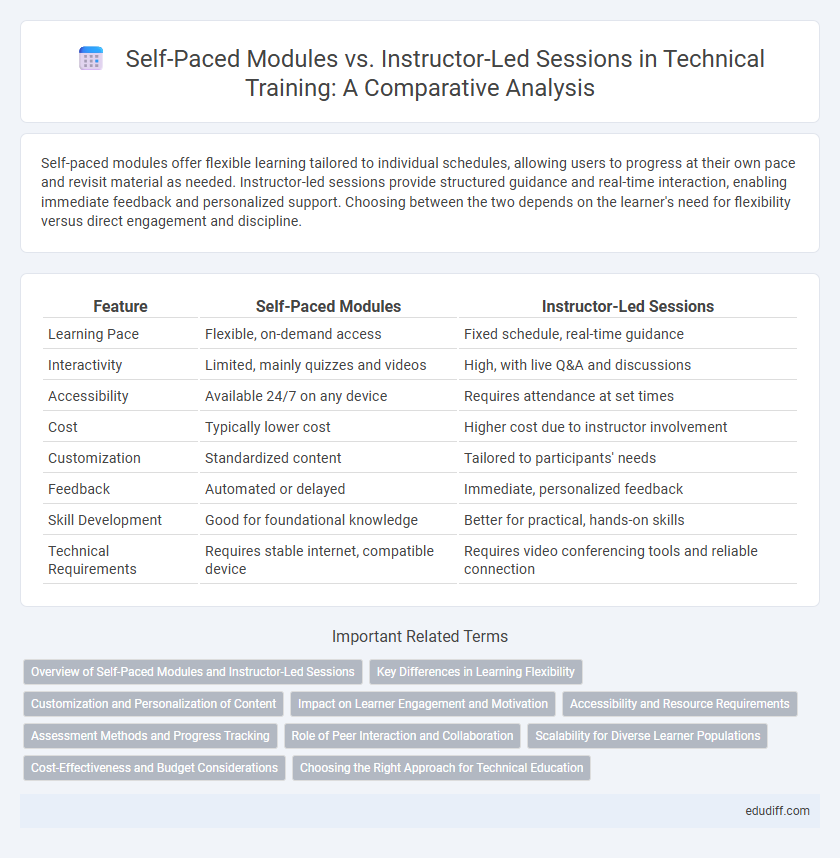Self-paced modules offer flexible learning tailored to individual schedules, allowing users to progress at their own pace and revisit material as needed. Instructor-led sessions provide structured guidance and real-time interaction, enabling immediate feedback and personalized support. Choosing between the two depends on the learner's need for flexibility versus direct engagement and discipline.
Table of Comparison
| Feature | Self-Paced Modules | Instructor-Led Sessions |
|---|---|---|
| Learning Pace | Flexible, on-demand access | Fixed schedule, real-time guidance |
| Interactivity | Limited, mainly quizzes and videos | High, with live Q&A and discussions |
| Accessibility | Available 24/7 on any device | Requires attendance at set times |
| Cost | Typically lower cost | Higher cost due to instructor involvement |
| Customization | Standardized content | Tailored to participants' needs |
| Feedback | Automated or delayed | Immediate, personalized feedback |
| Skill Development | Good for foundational knowledge | Better for practical, hands-on skills |
| Technical Requirements | Requires stable internet, compatible device | Requires video conferencing tools and reliable connection |
Overview of Self-Paced Modules and Instructor-Led Sessions
Self-paced modules offer flexible learning through pre-recorded content accessible anytime, allowing learners to progress at their own speed while revisiting materials as needed. Instructor-led sessions provide real-time interaction with experts, facilitating immediate feedback and dynamic discussions that enhance comprehension and engagement. Both methods leverage digital platforms, but self-paced modules emphasize autonomy, whereas instructor-led sessions focus on structured guidance and collaborative learning.
Key Differences in Learning Flexibility
Self-paced modules offer learners the flexibility to access content anytime and progress at their own speed, ideal for varied schedules and individualized pacing. Instructor-led sessions provide real-time interaction, structured timelines, and immediate feedback, supporting collaborative learning and accountability. The choice between these formats hinges on the learner's need for autonomy versus guided support in mastering technical skills.
Customization and Personalization of Content
Self-paced modules offer high customization by allowing learners to tailor their study schedules and select specific topics that match their individual needs. Instructor-led sessions provide personalized content through real-time interaction and immediate feedback, facilitating dynamic adjustments based on participant responses. Combining both methods enhances content personalization, leveraging the flexibility of self-paced learning and the adaptability of instructor facilitation.
Impact on Learner Engagement and Motivation
Self-paced modules offer personalized learning experiences that adapt to individual schedules, enhancing motivation through autonomy and flexibility, while instructor-led sessions facilitate real-time interaction and immediate feedback, boosting learner engagement via social presence and collaborative activities. Research indicates that self-paced learning increases motivation by allowing learners to progress at their own speed, whereas instructor-led environments foster higher engagement due to structured pacing and peer interaction. Optimizing training programs by blending asynchronous self-paced content with synchronous instructor-led sessions maximizes both motivation and engagement, leveraging the strengths of each approach.
Accessibility and Resource Requirements
Self-paced modules offer greater accessibility by allowing learners to engage with content anytime and anywhere, eliminating scheduling conflicts and geographical barriers. These modules require minimal resources, often needing only an internet connection and compatible device, reducing costs related to facilities and instructor availability. Instructor-led sessions demand dedicated times, physical or virtual classrooms, and real-time interaction, which can limit accessibility but provide immediate feedback and personalized support.
Assessment Methods and Progress Tracking
Self-paced modules employ automated quizzes and interactive tasks for continuous assessment, enabling learners to monitor progress through real-time dashboards and analytics. Instructor-led sessions utilize formative assessments such as live polls, group exercises, and direct feedback to gauge learner understanding and adapt instruction accordingly. Progress tracking in instructor-led formats often integrates attendance records and participation metrics, complementing assessment results to provide a comprehensive evaluation of learner performance.
Role of Peer Interaction and Collaboration
Self-paced modules offer flexibility but often lack the dynamic peer interaction that enhances collaborative learning and critical thinking. Instructor-led sessions facilitate real-time discussions, group projects, and immediate feedback, fostering deeper engagement and knowledge retention among participants. Peer collaboration in instructor-led settings stimulates diverse perspectives, which is crucial for complex problem-solving and skill development in technical education.
Scalability for Diverse Learner Populations
Self-paced modules offer unparalleled scalability by allowing diverse learner populations to access content asynchronously across different time zones and schedules, minimizing logistical constraints. Instructor-led sessions, while providing personalized interaction and immediate feedback, often face challenges in scaling due to limited instructor availability and the necessity of synchronized timing. Leveraging adaptive learning technologies within self-paced modules further enhances scalability by tailoring content to individual learner needs, optimizing engagement, and improving knowledge retention across varied demographics.
Cost-Effectiveness and Budget Considerations
Self-paced modules reduce costs by eliminating expenses related to instructor fees, travel, and physical materials, making them ideal for budget-conscious organizations. Instructor-led sessions, while typically more expensive due to live facilitation and personalized interaction, often justify the investment with higher engagement and immediate feedback. Balancing cost-effectiveness and learning outcomes requires evaluating organizational training goals alongside available budgets and scalability demands.
Choosing the Right Approach for Technical Education
Selecting the right approach for technical education depends on learner needs, content complexity, and desired interaction levels. Self-paced modules offer flexibility and scalability, allowing learners to absorb material at their own speed and revisit challenging concepts. Instructor-led sessions provide real-time feedback and hands-on guidance, essential for complex topics requiring immediate clarification and collaborative problem-solving.
Self-Paced Modules vs Instructor-Led Sessions Infographic

 edudiff.com
edudiff.com